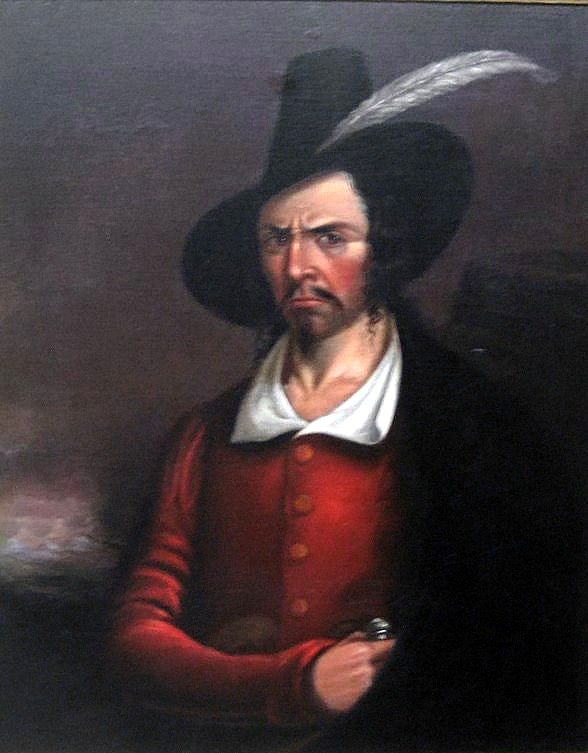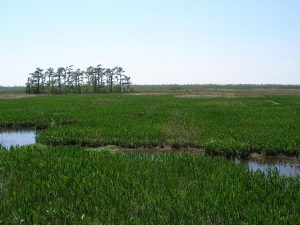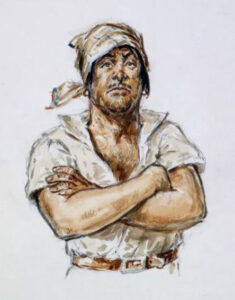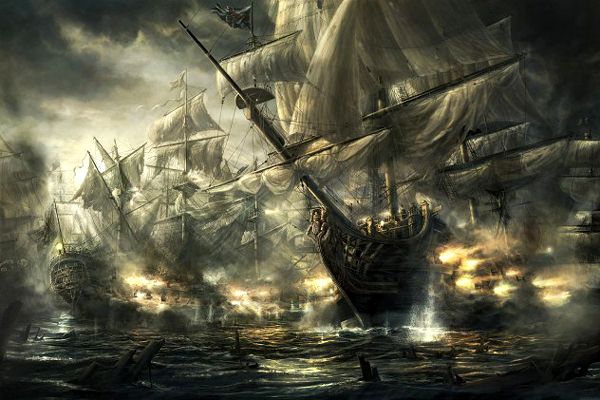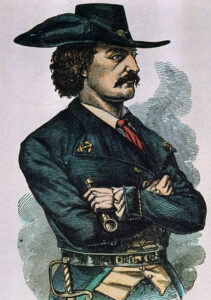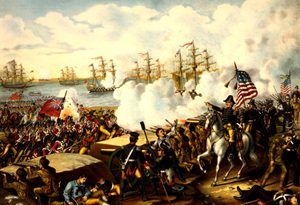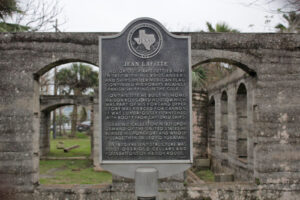By John R. Spears, 1903
On an unrecorded day between the purchase of the Louisiana Territory in 1803 and the year 1810, two brothers named Jean and Pierre Lafitte came to New Orleans and opened a blacksmith shop on the north side of St. Pierre Street, between Bourbon and Dauphine, where slaves were employed to do the pounding, while the proprietors looked for customers and made the collections.
Because of the changing circumstances of its previous existence, New Orleans was a remarkable town. It had been founded by a man who had observed that the site was convenient for carrying on a trade with Spanish America contrary to Spanish law. The smuggling trade received every encouragement until France ceded Louisiana to Spain in 1702. After that, many citizens turned to the French and British colonies for illicit commerce; and when the people of the Atlantic coast had settled in the Ohio Valley, traffic was opened with them. Every man in old New Orleans was aware of the smuggling business, and many, including the town officials, were engaged in it.
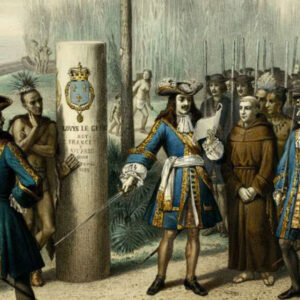
New Orleans history
Naturally, smuggling continued after New Orleans became an American city, but it was not until after 1808 that the trade reached its flood tide. For in that year, the importation of slaves become unlawful. The price of a prime individual on the African coast, in those days, was not above 20 dollars; but if offered in the market in New Orleans, with a clear title, he was worth $1000. The world never saw a more tempting opportunity for smugglers than the slave trade.
New Orleans was a frontier town as well as a seaport. Vast stretches of virgin land lay behind it, and settlers with money were flocking in to plant cotton, sugar cane, and tobacco. The demand for slaves far outran the supply.
Now the smugglers carried on their trade using boats, which were driven through the many waterways around New Orleans, and every such boat needed blacksmith work at one time or another. It was natural for the smugglers to patronize the Lafitte shop once it was opened, for both brothers had been sailors and officers on privateers and knew well the work needed on boats of all kinds.
Very soon, the Lafittes learned that the smugglers obtained their slaves from slavers trading between Africa and the Spanish West Indies. The slaves usually landed on Grande Terre Island in Barataria Bay and were carried through the bayous to a market along the Mississippi River. It was very profitable traffic, but to the mind of Jean Lafitte, who was the better businessman of the two brothers, it was managed in ways that wasted far too much of the profits. The men engaged in the business were all men of small means; they worked independently and paid more than was necessary for the “goods” they dealt. Jean Lafitte saw that general recognition of a “community of interests” would promote general prosperity, and he organized what was practically a smugglers’ trust.
The Trust and Its Methods
Sometime in 1810, the Lafitte brothers abandoned their smithy. Jean Lafitte went to Barataria to become the leader of the smugglers who gathered the goods, while Pierre remained in New Orleans and took charge of the sales department.
Sometime in 1810, the Lafitte brothers abandoned their smithy. Jean Lafitte went to Barataria to become the leader of the smugglers who gathered the goods, while Pierre remained in New Orleans and took charge of the sales department.
Under Jean’s directions, the smugglers united their forces. Then, instead of buying from Cuban slave traders, they went afloat in well-armed, well-manned vessels that lay in wait off the Cuban coast and intercepted the slave ships coming from Africa. This kind of a purchase,” as the old buccaneers called such a transaction, was entirely suited to the men under Lafitte, for the buccaneer spirit of hatred for the Spaniards had come down to them.
The success of Jean Lafitte’s work was so great that the Governor of Louisiana took note of it in September 1810 by means of an official proclamation denouncing “the open and daring course which is now pursued by the brigands who infest our coast.” Two whole cargoes of slaves had been brought through Barataria Bay in August and sold along the Mississippi River. More than a hundred of them were purchased and held in New Orleans.
The Governor’s proclamation merely advertised the “extensive and well-laid plan” which Jean Lafitte had laid for supplying the needy planters with slaves at very low prices for cash. Purchasers flocked to Barataria, and schooners of the long, low, rakish class and feluccas that were lower and more rakish still, were sent in growing fleets to rob the Spanish slavers.
From robbing slavers to robbing lawful merchantmen was a short step quickly taken. “It was ascertained,” said a Treasury Department document of the period, “that vessels clearing out from this port (New Orleans) with passengers have been captured and every soul murdered. They took vessels of every nation indiscriminately, and the fact was perfectly known.”
The Pirates’ Headquarters
In his prosperity, Lafitte built a fort on Grande Terre Island with a home inside its walls and many houses for resorts that were attractive to the seamen who manned his piratical ships. His wealth increased, and his influence spread. A fleet numbering at least ten vessels was under his command within a year or two. According to the season, the number of men who obeyed his orders was officially stated from 800 to 1,000. The lawless hordes of the West Indies gathered to do the bidding of this one man at the pirate resort.
“A well made, handsome man” was Jean Lafitte, as one who knew him well once said. He was “about six feet two inches in height, strongly built; he had large hazel eyes, black hair, and he generally wore a mustache. His favorite dress was a species of green uniform, with an otter-skin cap which he wore a little over the right eye. He was gentlemanly in his deportment, of sober habits, and very thoughtful. Independently of his own language, he spoke Spanish and English fluently.
“When roused, he could be desperate indeed and was a good swordsman and unerring shot. There was no adventurous love tale to tell of him,” but he “had a criolla mistress, a native of New Orleans. His table was well but not prodigally supplied. There was much order and regularity in his household affairs, and there was an abundance of plate, linen, etcetera.”
Until 1814 Jean Lafitte ruled his pirate kingdom with but little interference from government officers. United States marshals attempted an occasional raid, but they were always defeated. After one fight, in which Lafitte commanded in person, he said to the revenue officers who survived:
“I desire you to know that I am averse to such strifes, but at the same time, you must distinctly understand that I prefer losing my life rather than my goods.”
In the meantime, despite the raids, Jean Lafitte came and went between New Orleans and Barataria at pleasure. Government officials often learned when he was in town. Appeals made by honest merchants for suppressing the gang that undermined their trade went unheeded until 1814. Then, when the United States district attorney drew an indictment, it was so defective that conviction was found to be impossible—a fact from which suspicious people might draw inferences.
A Patriotic Pirate
During the War of 1812, when the British came to attack New Orleans in the latter part of the year 1814, they sought Lafitte’s help, offering him a captain’s commission, abundant lands, and a free pardon for the capture of all ships that had been taken under the British flag. But Lafitte and his men hated the British and loved New Orleans. Even then, an American expedition was fitting out under Commodore Patterson to destroy the Barataria resort, and Lafitte knew all about it, but he refused to join the invaders. On September 16, 1814, Patterson’s force destroyed Barataria. Capturing ten cruisers belonging to the pirates and one prize they had brought in, with property worth not far from $150,000. The Baratarians had to flee to the swamps. From his hiding place Jean Lafitte appealed for permission to fight under Andrew Jackson, and he paid Edward Livingston and the United States district attorney, John K. Grimes, then the most influential men in New Orleans, no less than $35,000 apiece to advocate his cause. The two succeeded in obtaining Jackson’s favor for him, and Lafitte was in the Battle of New Orleans, though what he did there has never been recorded. And under the date of February 6, 1815, President James Madison granted “a full and free pardon ” to all the pirate horde.
Nevertheless, Lafitte’s career was not yet half ended. There little record of his doings for two years after his pardon. He did a little business in the old way at Barataria, but he did not get reasonably afloat again until 1817.
Galveston’s Piratical Beginnings
In the autumn of 1816, a piratical leader named Louis D’Aury, from the insurgent hosts of Spanish America went to the island where Galveston, Texas, now stands and in a small way, created there a resort similar to Lafitte’s at Barataria. The cruisers, which, under various Spanish American flags, were ravaging the seas, needed a port where they might refit and dispose of cargoes—particularly slaves— that could not be sold openly. D’Aury’s name is worth recording because he was the originator of a most remarkable “bluff.” With a few hundred men, and enough lumber and tents to build shelters for them on an empty beach, he lauded on Galveston Island and established what he called the capital of the independent nation of Texas. He had conquered Texas from the Spanish, he said, and he organized a new government, thereby issuing a proclamation. His government had two departments—an executive, at the head of which was D’Aury, and a judicial department, or court of admiralty. D’Aury supposed that vessels condemned by this court would be admitted, with their cargoes, to the ports of the United States, as were lawfully condemned prizes from actual nations. Still, he was of a fickle mind, and in April of the following year (1817) he abandoned his island capital to find another location.
To D’Aury’s abandoned capital, a tumbledown collection of shanties, came Jean Lafitte; and on this Texas sandbar, he founded a greater pirate colony than Barataria Bay. The Spanish American insurgent leaders had given cover to the pirates of the West Indies by issuing a commission to cruise against Spanish commerce to every ship captain that applied for one. These commissions proved to be efficient neck protectors; even the Spanish did not often hang the crew of a captured privateer that had such a document. But, when the cruisers wished to dispose of their prizes, the only market worthwhile was a port of the United States. That was a market where their commissions and traffic were scrutinized with steadily increasing severity. To reach the American market without undergoing this scrutiny, many piratical cruisers headed for Galveston harbor, where they were received as of old at Barataria. The distance to the plantations where slaves could be sold was longer, but the journey was made by boats through bayous where the revenue officers never came to molest the smugglers.
Moreover, Lafitte bought cheap and charged exceedingly attractive prices. To Colonel James Bowie, the inventor of the famous knife, slaves were sold at one dollar a pound or an average of $140 each. To get them on the market, Bowie took them openly to New Orleans, where he had them seized by the officials and sold as a lot at auction. At these auctions, no competitors appeared, and Bowie bought them at prices that enabled him to clear fifty thousand dollars in a year or two.
There is little record of fighting in the story of Lafitte. He learned that the crew of one of his ships had planned a mutiny on one occasion. He allowed them to go ahead unmolested until they charged on the cabin at midnight. Then he gave them a reception that stretched six of them dead on the deck and wounded several more. One of his captains challenged him to fight a duel after a dispute over the ownership of a box of gold watches. Jean accepted, and they went to Bolivar Island to fight; but when they had landed on the beach, the look on the face of Lafitte so cowed the captain that he fell on his knees and begged for mercy; at which Jean cuffed and kicked him and let him go.
At Galveston, Lafitte proclaimed from time to time the forms of a national government, and he hoped that his courts might obtain recognition, but with such citizens as were available, the task was beyond him. Nevertheless, he made an entire success of the port as a pirate “fence.” An American filibuster general, James Long, visited the place and found a thriving settlement with “gold pieces as plentiful as biscuits.”
Lafitte’s Decline and Fall
But, beginning in 1819, one after another of Lafitte’s cruisers was captured while engaged in open piracy; some of the crews were hanged under sentence of the United States courts, and in the spring of 1821, the famous little Yankee warship Enterprise went to Galveston and compelled him to leave. It is notable that while men from his cruisers were hanged, he was not even arrested. He gathered his plunder into a beautiful brig called the Pride, a vessel of 14 good guns, well manned, and on an unnamed day, he sailed away, headed to the southeast. And there, authentic accounts of Jean Lafitte come to an end. Some say he perished in Yucatan, some that he died in France, and one writer says that he met his end fighting an American warship off the south coast of Cuba.
But whatever his fate, his career was the most remarkable known in the annals of piracy. Henry Morgan once gathered a larger force, but that was in the 17th century, while Lafitte did his work in the 19th. Morgan held his horde together for one assault only, while Lafitte held from 500 to 1000 men from 1810 to 1821. It was a band of desperadoes gathered from the slums and prisons of all civilized nations and the coasts of heathendom. They were men without a country, without a conscience or a hope beyond the gratification of appetite. They knew well the exhilaration that comes to wild souls in deadly conflicts. Mutiny—the defiance of law and authority—was the chief feature of their chosen occupation, but Jean Lafitte ruled them. They called him “the old man” when they talked of him, and when they addressed him, they called him “bosse” (meaning literally prominence), and so added a word to the American language. He rarely associated with his followers and seldom smiled. “When roused, he could be desperate indeed,” says a historian, but his men were his friends and his followers. Moreover, during 11 years, he was able not only to influence the authorities of Louisiana in his favor but to shield himself from the attacks of the Federal government.
Lafitte was a pirate and was guilty of the blood that his men shed and the blood that he shed with his own hands, but he was by no means wholly devoid of the qualities that go to the making of a hero.
By John R. Spears, Munsey’s Magazine, Volume 28, Frank A. Munsey Company, 1903.
Compiled and edited by Kathy Alexander/Legends of America, updated May 2022.
Also See:

